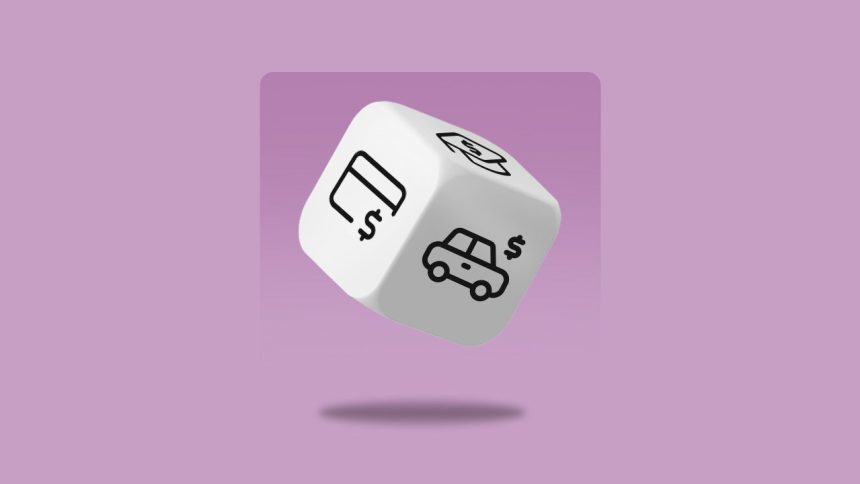Key takeaways
- Always try to make at least the minimum monthly payment on every outstanding balance.
- When deciding which debt to pay off first, consider its type, interest rate, outstanding balance and impact on your credit score.
- Some strategies to pay off debt include the “highest interest first” strategy, the “smallest debt first” strategy and debt consolidation.
- To choose the right strategy, consider your overall financial situation and long-term goals.
Prioritizing debt repayment requires a hard look at your finances. List your debts, along with the interest rate, minimum monthly payment, outstanding balance and estimated payoff date. Then, ask yourself:
- Which of these accounts impacts my budget the most?
- Will paying off a certain debt make more of a difference in my life than paying off others?
- How much extra can I realistically put toward repayment without overstretching my budget?
- Is there an account small enough that can be paid off quicker than others?
Answering these questions — along with using a debt paydown calculator — can give you a better grasp on what your debt repayment strategy should be.
How should you prioritize debt payments?
Prioritizing debt repayment is all about knowledge, meaning you’ll need to take a hard look at your finances to know where to start. List all your debts, along with the minimum monthly payments, outstanding balance and estimated payoff date. Then, ask yourself the following:
- Which of these is impacting my budget the most?
- What would my monthly budget look like if I didn’t have this account anymore?
- Will paying off this debt make more of a difference in my life than paying off these others?
- How much extra can I realistically put toward debt repayment without risking my budget?
- Is there an account small enough that can be paid off quicker than others?
Answering these questions can give you a better grasp on what your debt repayment strategy should be. You can also use a debt paydown calculator to help answer these questions.
Consider these factors before deciding which loan to pay off first
Delinquent accounts
If you have any debt that’s overdue, start there. Delinquent accounts can have a substantial impact on your credit, just like accounts in collections, so those should be your first priority.
This advice is especially critical if you have a delinquent secured loan, like a mortgage or an auto loan. Fall behind on that debt and you could forfeit your home or car, not just the plastic in your wallet.
Despite the risk, auto loan delinquencies (7.54 percent) are actually higher than their credit card (6.93 percent) counterparts, according to a March report using data from the New York Fed Consumer Credit Panel and Equifax.
Type of debt
Some debt, like overdue taxes, may require more urgent attention than, say, paying off your car loan early. That’s because nonpayment to the IRS could lead to serious consequences, such as wage garnishment and seizure of your property.
There are also complications around choosing which student loan to pay off first. If your federal loan is in on administrative forbearance or stuck in SAVE limbo, for example, you could make extra payments toward private student loans that don’t enjoy such reprieves.
Interest rate
Some debts, like personal loans, have a fixed interest rate — others, like credit cards, have variable rates. The latter can fluctuate depending on market conditions, making it harder to budget and pay off your debt.
Debts with higher interest rates are also more expensive in the long run. That makes them a priority, at least mathematically, to pay off first — something that will be covered in the “high-interest first” strategy.
Outstanding balance
It may be wise to tackle a debt with the lowest balance, as this will give you momentum to keep going — this will be covered in the “smallest debt first” strategy.
Also, if you have a revolving debt that’s up against your credit limit, lowering it first could mean a significant boost to your credit score and a better chance of securing better rates in the future.
5 best ways to pay off debt
1. The “high-interest first” strategy
Paying off high-interest debt first is commonly referred to as the avalanche method. This involves making the minimum monthly payments on all of your credit cards and loans, but putting every extra penny you can toward the card or loan with the highest interest rate.
Using the avalanche method can be a smart move since you’re taking care of the costliest debt. However, it isn’t necessarily the best option for everyone. If you have multiple accounts with similar interest rates, for instance, it may not be the best approach. The avalanche method might also be discouraging if you have a large balance, since paying it off could feel impossible and slow your momentum.
Example
- Credit card one: $500 balance and 20 percent APR
- Credit card two: $1,000 balance and 21 percent APR
- Auto loan: $20,000 balance and 8 percent APR
- Personal loan: $5,000 balance and 12 percent APR
- Student loan: $12,000 balance and 7 percent APR
You’ll make the minimum payments on all your accounts, but apply any extra funds for the month to credit card two since it has the highest interest rate. Once it’s paid off, you’ll continue the same pattern by focusing on credit card one, followed by the personal loan. Repeat this cycle until all the balances are paid in full.
- Key advantages: Allows you to save money on interest.
- Key drawbacks: If your largest debt also has the highest interest rate, it could take a while to pay it down. This may discourage you, increasing the likelihood of giving up on the strategy.
- Better if you’re… looking to minimize your interest costs.
2. The “smallest debt first” strategy
While some people choose to address their debt based on the interest rate, others pay off their smallest debt first and work their way up to the largest one. This debt repayment approach is known as the snowball method because it starts small and grows over time.
The snowball method works because paying off a debt in full incentivizes you to keep working toward your goal. As you pay off your smaller debts, you’ll have more money to put toward your larger debts.
You’ll end up paying more interest than you would have paid if you tackled your highest-interest debt first, but the psychological benefits of zeroing balances quickly can be very rewarding.
To get started, list all of your current debts — and their current balances — from low to high. Continue to make the minimum monthly payment on all of your debts while putting as much extra money as possible toward your smallest debt. Once that account is paid off, put your extra money toward your next-smallest debt, and so on.
Example
Using the same figures as the “high-interest first” strategy, start by focusing on credit card one since it has the lowest balance. After it’s paid off, move on to credit card two, then the personal loan.
- Key advantages: Builds motivation and encourages you to stick with the plan.
- Key drawbacks: It may take longer to become debt-free, and you could pay more in interest than with other methods.
- Better if you… struggle to stay motivated about paying off debt.
3. Repaying the debt that most affects your credit score
Your credit utilization ratio — the amount of your credit limit on revolving accounts compared to what you’re using — accounts for 30 percent of your FICO credit score.
So, if you have revolving debt that’s using up a high percentage of your limit — say, far more than the general rule of 30 percent maximum — prioritizing it for payoff could stop your credit score from falling.
Example
- Credit card one: $750 ($1,000 credit limit, 75% credit utilization)
- Credit card two: $1,500 ($3,000 credit limit, 50% credit utilization)
- Credit card three: $250 ($2,500 credit limit, 10% credit utilization)
- Auto loan: $25,000
- Student loan: $15,500
Since your credit utilization significantly impacts your credit score, pay down credit cards with high utilization rates — both overall and per card. Start by focusing on those with utilization rates over 30 percent. Reducing the utilization of these two will give you the best chance at improving your credit score alongside paying your other bills on time.
- Key advantages: You’ll have more opportunities to qualify for lower APRs and receive increases in spending limits to meet future financing needs.
- Key drawbacks: Focusing on your credit score may also require lifestyle changes, making it easier to lose motivation.
- Better if you’re… looking to eventually finance a large purchase, such as a house or a car.
4. Use a balanced method
There are common scenarios that many consumers face, including:
- Attacking your largest balance may feel like a years-long, insurmountable process.
- Deprioritizing smaller balances can help you address pressing circumstances, like debts that have fallen into collections.
- Delaying repayment on accounts that qualify for interest deductions — like a student loan or a home equity loan used to buy, build or substantially improve your home — can preserve tax benefits.
Taking a balanced approach that’s exclusively your own may be best in some of these scenarios. You can incorporate any of the first three debt repayment options in whichever order you desire. For instance, you could eliminate a debt that’s in collections before paying your highest-interest or highest-balance credit card down, making only minimum payments on your other accounts in the meantime.
Example
Using the same figures in option three, you could start by paying off credit card three, since it has the smallest balance. You could also start with the debt with the highest monthly payment or interest and work your way down. Or you could divide any extra money you have each month and apply a little extra to each debt. Ultimately, you have to develop a sustainable strategy so you won’t lose momentum during the payoff process.
- Key advantages: Make your debt repayment plan your own. If you have an emergency, you can manage the expense without sacrificing your goal of getting out of debt.
- Key drawbacks: Without a clear strategy, you could lose motivation.
- Better if you… need more flexibility but can stay disciplined.
5. Consolidate your debt
You have a few options if you want to consolidate your debt into a single monthly payment.
| Consolidation method | In a nutshell | Fine print |
| Debt management plan (DMP) | Working with a nonprofit credit counseling agency, come up with a plan to zero your debt after three to five additional years of repayment. | DMPs only work for unsecured debt and typically limit your access to new credit while you’re enrolled. |
| Lower-rate debt consolidation loan | If you can find a loan with considerably lower interest rates than what you’re currently paying, you can decrease the overall cost of your debts. Use a debt consolidation calculator to figure out how much you could save. | Origination fees can eat into your potential savings, and lengthening your loan term can allow additional interest to accrue, increasing the total cost of your repayment. |
| Balance transfer credit card | The top balance transfer credit cards offer a 0 percent promotional APR for between 15 and 21 months on balance transfers, giving you ample time to start paying off your debt without paying interest on your transferred balance. | Not paying off your balance before the promotional APR expires would mean facing steep credit card interest rates. |
| Home equity loan or line of credit | A home equity calculator can help you determine whether tapping your property ownership to pay off your debts can save you money. | These products require you to have a significant amount of equity in your home, and can take a long time to fund. Plus, if you fall behind on payments, you risk foreclosure. |
| Debt relief company | A debt relief company can help you consolidate your accounts into one monthly payment and potentially settle your debt — for a fee. | A last-resort option. Debt relief companies require you to stop making payments, which can damage your credit and pile on late fees. |
- Key advantages: You could receive a lower interest rate, simplify your finances and repay your debt faster.
- Key drawbacks: There could be upfront costs, and there is a chance you may not qualify for a lower interest rate.
- Better if you’re… making multiple monthly payments with high APRs.
Bottom line
There are several debt payoff methods to choose from, and you could combine any of these strategies to create a plan that keeps you motivated. Just be sure that whatever plan you choose is realistic for you to execute. Put it in writing and commit to staying the course until you reach the finish line. And if you are going to seek out a debt consolidation loan, review current personal loan rates before applying.
Read the full article here














